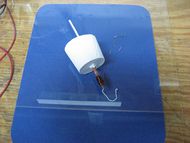Electroformed Nozzle
Release status: Experimental
| Description | Electroformed copper hot end
|
| License | unknown
|
| Author | |
| Contributors | |
| Based-on | [[]]
|
| Categories | |
| CAD Models | |
| External Link |
Contents
Introduction
The purpose of this experimental design is to take a step toward a more "replicatable" hot end. The procedures outlined here could potentially be used to make a functional hot end using basic raw materials and simple processes, without the need for precision tools such as a metal lathe or drill bits and other cutting tools.
The main tube is electroformed copper.
The insulating portion is cast plaster.
The heater coil is made of enamel insulated copper wire.
Temperature feedback is accomplished by measuring the resistance of the copper heater coil.
The purpose is not to make a more reliable hot end, or to use readily available components. For that, there are many well-established designs that use custom machined parts (such as Arcol.hu_Hot-End_Version_3.0 or J_Head_Nozzle) and others that minimize the need for machining by using off-the-shelf components (such as North90's_hot-end_V2 or DIY_Direct_hot_end) or even hand-made Glass_Nozzles.
Making the electroforming mandrel
A master form was machined manually out of wax using a small lathe. The main shaft has 3mm diamter and length of about 30mm. The smaller portion that forms the orifice has 1mm diameter and length 2.5mm. A silicone mold is made from the master. Cerroshield alloy mandrels are cast in the silicone mold. The metal mandrel is then partially dipped in molten wax in order to mask off certain regions, including the sides and the tip.
Electroforming
A standard copper electroforming solution is prepared from 500 mL distilled water, 67 mL of 40% concentration sulfuric acid, and 50 grams of copper sulfate. Warning! The plating solution is toxic. Use proper lab procedure when handling.
The wax-masked mandrel gets immersed in the electroplating solution. The positive terminal on a 3V power supply connects to the copper sheet electrode through a 10 ohm current-limiting power resistor (rated 10W). The cast metal mandrel connects to the negative terminal on the power supply. Electroforming proceeds at about 270 mA for 8 hours.
Finishing and casting insulator
After electroforming, the mandrel is removed from the plating solution and rinsed off. Then it goes into a boiling water bath, and the Cerroshield alloy and wax melt away from the copper. No other finishing steps (drilling, filing, deburring, etc) are necessary. The wax and cerroshield are recovered and recycled.
The copper shell is placed in a cup (used as a mold) and a piece of 3mm filament serves as a mold core. Standard plaster of paris is poured into the cup. After the plaster hardens, the cup and filament are removed. We now have a copper heater barrel embedded in an insulating plaster block.
Pictures
Determining heater coil parameters
The wire diameter is 0.008 inch. Enough wire is wound on the barrel to make a coil of about 4.5 ohms.
Copper has a temperature coefficient of resistance of about <math>3.9 \times 10^{-3}</math> in units of <math>C^{-1}</math>. Compare with <math>0.4 \times 10^{-3}</math> for nichrome.
This means that a copper coil that is 4.5 ohms at room temperature (25C) will have a resistance of about 8 ohms at 225C (and around 6 ohms at 120C). There is a handy calculator at hyperphysics. See also the Wikipedia entry on resistivity and conductivity.
The temperature dependence of the heater coil resistance can provide feedback for temperature control, although it is probably not as stable or easy to read and calibrate as a thermistor.
Results
The extruder can operate up to about 120C. At this temperature it can extrude Polycaprolactone (see pictures). 120C is also hot enough for a nozzle to function as a wax vacuum. The limiting factor is the insulation on the copper wire - above 120C it fails and the coil shorts out. High temperature insulation might work better. Another option is to encapsulate bare copper wire in a ceramic. Or simply use nichrome wire and kapton tape.
Next Steps
There are several ways that this procedure could be made more automatic. For example, a paste extruder on a reprap can make a silicone mold directly, which can be used to cast the metal mandrel. Other options include using a soluble support material as the mold, or even 3D printing a plastic mandrel which is then coated with conductive paint.
Of course, the mold and/or mandrel must have an acceptable surface finish so that the melting filament does not jam, and the resolution of the printing process limits the minimum size of the orifice. However, a careful design of mold or mandrel that accommodates the printing limitations may be feasible.
Utility of electroforming in different hot end designs
There are several designs for all metal hot ends. Many of them use a metal tube with a "heat break", often made of stainless steel because of its lower thermal conductivity. The heat break principle is effective even for metals with good thermal conductivity such as brass. So, even though electroformed copper has fairly good thermal conductivity, this approach may be useful for creating a variety of all-metal hot ends. The electroforming process may also work for creating subtractive tools such as the Waxuum.
In principle, a hot end with very small orifice could be made by using a fine wire or needle as part of the mandrel, reminiscent of this method used to make a piezo-driven Reprappable-inkjet.
Electroforming works for many metals that have desirable properties (such as nickel). The electroforming method may serve to be a useful technique for converting other 3D printed forms into metal parts.









